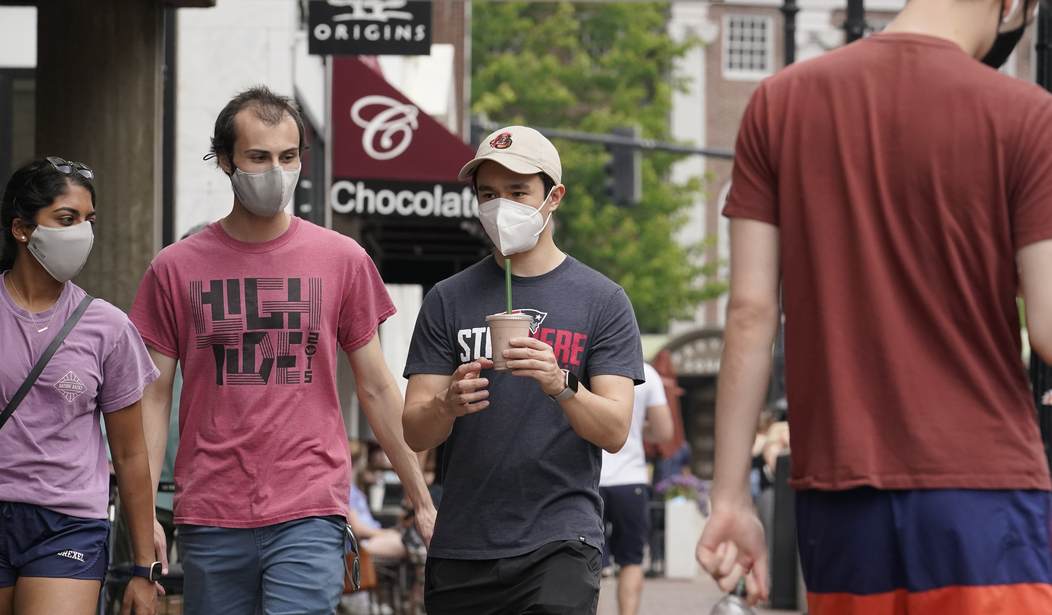I’m unprepared to process optimism about COVID, seeing as how there’s been a grand total of three or four weeks of it since March 2020.
We had that one shining moment in May when millions a day were getting vaxxed and cases were finally in decline. We were turning the corner. The pandemic was ending!
Then came Delta.
Are we turning the corner now? A group of researchers advising the CDC crunched nine different models of the pandemic’s predicted trajectory over the next six months to create one mega-model. Because last winter was a nightmare and was caused by a strain far less transmissible than the new variant, logically you’d expect this coming winter to be apocalyptic. Not so, say the modelers. On the contrary, the golden age of herd immunity may soon be upon us:

The model anticipates 59 deaths per day circa mid-March 2022. Yesterday the United States topped 2,200. It seems impossible but researchers insist that it isn’t — even with the expected boost in transmission over Thanksgiving and Christmas as people gather to celebrate. The fact that America (at least its southern half) had such rough summer means winter will necessarily be milder. Delta’s already burned through millions of unvaccinated people, either killing them or rendering them immune. Eventually the variant will run out of kindling.
But there are three variables that will affect how bad things get. One is the number of children who get vaccinated or infected, reducing vectors of transmission across the population. The most optimistic scenario modeled imagines that lots of kids will be immunized once they’re eligible. But is that scenario too optimistic?
Even though doctors say there is a greater risk of spreading the coronavirus to those who already have the vaccine if you are unvaccinated, Lopez said he’d do “anything to keep [his kids] safe, but I can’t just be the first in line.”…
A sizable minority — 4 in 10 parents of children ages 5 to 11 — say they’ll take a “wait and see” approach before they have their children vaccinated, according to a survey from the Kaiser Family Foundation.
Another 26% will do it “right away,” while 25% say they will “definitely not” make their children get the shots. Nine percent said their child would only get the shot if required, according to the poll conducted from mid-July to early August.
Just a quarter of parents are prepared to have their young children take the jab once it’s available. Many kids will gain immunity one way or another during this coming school year but it may take longer than we expect.
The second variable is a new variant arising that supplants Delta. That would be a tall order for evolution since Delta is already hyper-transmissible, reaching hosts more quickly than other strains can, but scientists are keeping their eyes on one out of Japan known as R.1. It’s already in the U.S. and making trouble for some unlucky people, not all of whom are unvaccinated:
A new variant of the COVID-19 virus has been identified at a Kentucky nursing home, where it infected 45 residents and workers, many of whom were vaccinated.
The R.1 variant originated in Japan, and contains dangerous mutations that can improve “transmission, replication, and immune suppression,” a scientist wrote in Forbes Monday.
There are already more than 10,000 entries of the R.1 variant in a database used by researchers to track genomic material, infectious disease expert Dr. William Haseltine said.
A variant that could bust through people’s immunity and reinfect them would be a gamechanger for the trajectory of the pandemic, needless to say.
The third variable is testing. Biden has promised to make rapid at-home tests cheaper and more ubiquitous but even the feds’ best efforts at this point probably can’t get us on par with Europe, where tests are everywhere and cost less than a candy bar. Yesterday David Leonhardt wondered how different this graph might look if the U.S. had enough tests available to let everyone get checked before attending a gathering. Test positive at the door and you don’t enter, cutting off a conduit of transmission for the virus. That’s how they do it in countries like Germany. Not here:

Experts told Leonhardt that if Biden were to reclassify antigen tests as a “public health tool” rather than a “medical device,” that would cut much of the red tape that’s slowing down approval and cheap tests would soon flood the market. Whether they’d do so in enough volume, and at a low enough price point, at this stage to meaningfully reduce transmissions and deaths is another question. How much can lower-income people realistically afford to spend each week on testing? An Operation Warp Speed for cheap tests last year parallel to the one for vaccines could have changed a lot.
One last grim note. Even if the model is correct that we’re now in a long endgame stage towards endemic COVID, there are many deaths to come on the downslope. The optimistic scenario is that we’ll reach 780,000 dead by March, or 100,000 more than we’ve recorded so far. And one scientist told Stat that once COVID becomes a seasonal disease, he expects it to become our worst of the winter, with something like three times more cases and deaths annually than Americans suffer from the flu. As a reminder, the flu kills anywhere between 20,000 and 60,000 people each year. We could see yearly death tolls of 100,000+ semi-regularly from COVID in the future if that scientist’s prediction is right.
I’ll leave you with this depressing vignette from pandemic-era America.
A Texas couple with an immunocompromised infant was kicked out of a restaurant for wearing masks.
“They told us if we didn’t want to take our masks off, we were going to have to close our check and leave,” says Natalie Wester. pic.twitter.com/Opw3byioGe
— Brianna Keilar (@brikeilarcnn) September 22, 2021







Join the conversation as a VIP Member